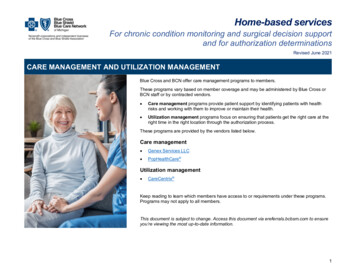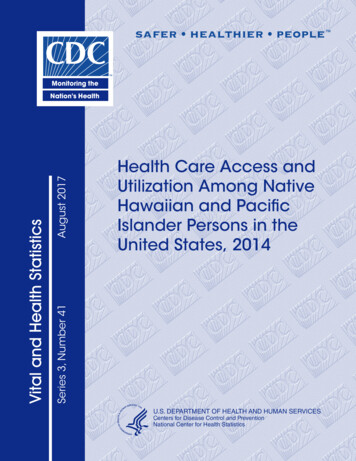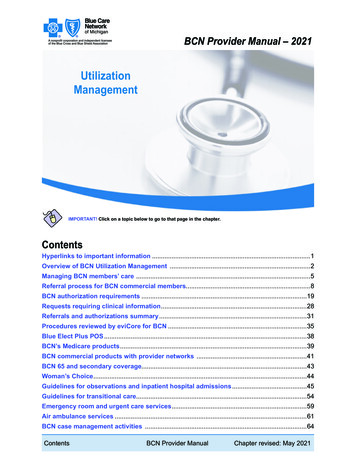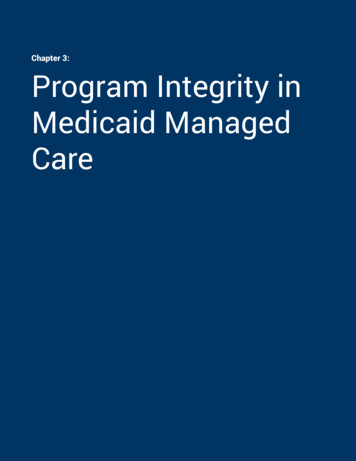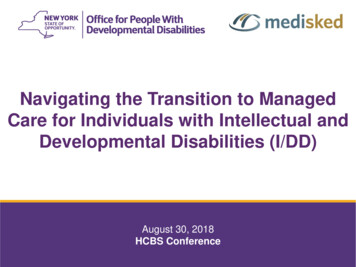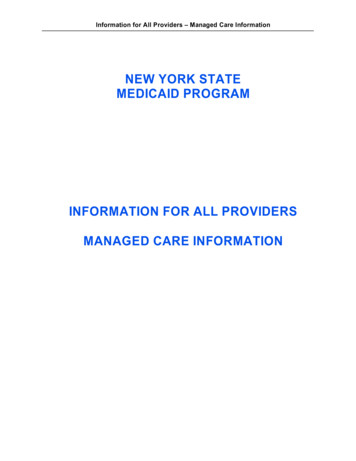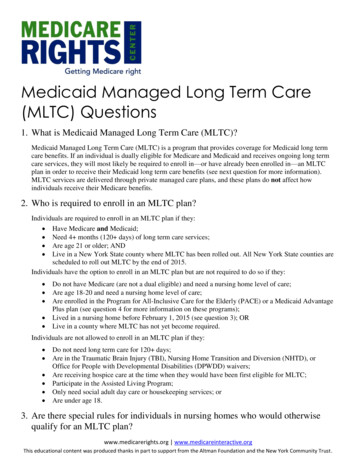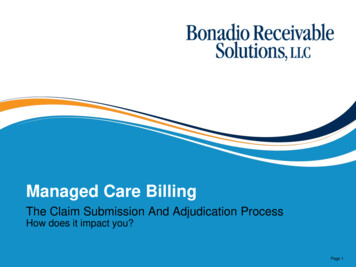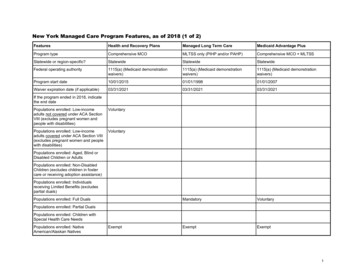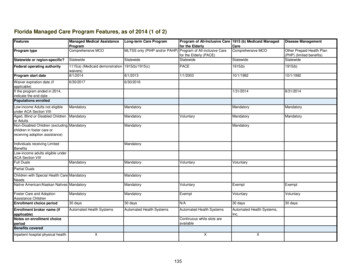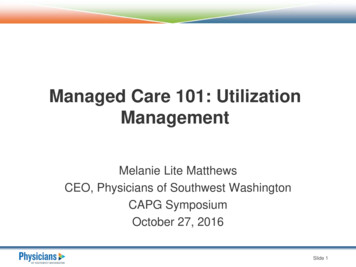
Transcription
Managed Care 101: UtilizationManagementMelanie Lite MatthewsCEO, Physicians of Southwest WashingtonCAPG SymposiumOctober 27, 2016Slide 1
Content OverviewBackground to importance of coordinated care– Building the Will Coordinated Care is the future: Think MACRA .– Outcome Data supports Utilization ManagementWhat is Utilization Management?– Essentials of Utilization Management Population Health– Advanced Care Management Importance of Comprehensive Primary Care and Primary CareMedical Home Models? Payor Contracts and UM Silos of Concern and Importance: Pharmacy and Behavioral HealthSlide 2
MACRA: Demise of FFS and Volume BasedReimbursement for Medicare BeneficiariesMIPS and APM models all promote quality and cost MIPS – criteria applied to 2017 services–––– 0% based on cost of care60% based on quality of care15% based on clinical care improvement activities25% based on advancing care information (formerly ‘meaningful use’)Impact: /-4% adjustment to 2019 FFS, with winners and losersAlternative Payment Models– Must be participant in designated APM model including accountabilityfor quality and costImpact: 5% increase to 2019 FFS reimbursement – all winners!Commercial and Other Payors Historically Follow MedicareSlide 3
Cost of Care Remains a ProblemSlide 4
AtlasCoverage5A Study to see regional variation, and to compare the performance of integrated care vs. fragmented careSlide 5
7All across CA,HMOOutperformsPPOin 5out of 6 clinicalquality measuresSlide 6
9HMOs:Higher QualityLower CostPPOs:Lower QualityHigher CostSlide 7
Bottom Line: Health Care Reform is Here Many physicians and physician groups are not aware of MACRA andhow it will impact their Medicare reimbursement, first for Medicare and likelyother payors to follow. Physicians and other providers need to align with others, includinginstitutions and select payors, and collaborate in very different ways.Integrated medical groups on a common EMR have head start in datasharing; IPA structures can provide infrastructure for those not employed byan integrated health system or insurer. Timely and accurate clinical and cost data is essential to improvingquality lowering costs. Building and sustaining this data infrastructure iscomplex and very expensive. Interoperability of electronic medical data isgoal but far from current reality. Some payors reluctant to share detailed costdata.Physician provider agreements with payors demand data and may or may notdelegate UM functions to the medical group or IPA. If capacity to accept delegationis not yet present, or key payor refuses to delegate, agreements need to hold payoraccountable for timely sharing of UM data with clinical providers.Slide 8
AtlasIHAAtlas MeasuresMeasures6Slide 9
Utilization Management: DefinitionURACUtilization management (UM) is the evaluation of the medicalnecessity, appropriateness, and efficiency of the use of healthcare services, procedures, and facilities under the provisions ofthe applicable health benefits plan, sometimes called “utilizationreview.”IOM’s Committee on Utilization Management by Third Parties(1989)A set of techniques used by or on behalf of purchasers of healthcare benefits to manage health care costs by influencing patientcare decision-making through case-by-case assessments of theappropriateness of care prior to its provision.Slide 10
More current and explicit descriptions ofUtilization Management (UM)Wikipedia Definition:“ the evaluation of the appropriateness and medical need of health careservices and procedures and facilities according to evidence-based criteria orguidelines, and under the provisions of an applicable health benefits plan.Typically, UM addresses new clinical activities or inpatient admissions based onthe analysis of a case, but may relate to ongoing provision of care, especially inan inpatient setting.”URAC standards are intended to ensure that the UM process “ is clinicallysound and respects patients’ and providers’ rights while giving payersreasonable guidelines to follow. URAC’s standards address the use ofevidence-based guidelines, outline specific reviewer requirements for eachlevel of review, and require a policy preventing financial incentives todoctors and other providers based on consumers’ use of health services ”Slide 11
NCQA Utilization Management Standards andGuidelinesUtilization Management ComponentStandards and GuidelinesInternal Quality Improvement ProcessClinical InformationAgreement and Collaboration withClients– e.g., DelegationDenial NoticesPrivacy and ConfidentialityPolicies for AppealsUM Program StructuresAppropriate Handling of AppealsClinical Criteria for UM DecisionsSatisfaction with the UM ProcessCommunication Services (access tostaff)Emergency ServicesAppropriate ProfessionalsTriage and Referral for BehavioralHealthcareTimeliness of UM DecisionsDelegation of UM ActivitiesSlide 12
Other Standards for UM Procedures CMS Managed Care Manual State Insurance Regulatory Bodies Individual Health Plans and Payor Requirements Specialty Medical Society GuidelinesImpact for Medical Groups Involved in UM: Standards may vary among payors and between plans and the UM process must be flexible tohandle differing requirements. Conflicts can arise particularly between CMS and State Regulatory bodies with regard to MA plans,with CMS regulating plans with the exception of licensure and financial solvency matters. Specialty societies may also disagree on preferred preventative screenings and their frequency, andon treatment recommendations. Different timeliness standards may apply between payor contracts, often referred to as TATs. Different documentation and communication tools may be required among payors. Interpretations of whether standards are being implemented correctly can vary among auditors forplans and CMS at delegation audits, particularly focused on necessary provider and patientcommunications in the event of a denial.Slide 13
Potential Issues with Criteria Payors may use different criteria and may require their data set be applied fortheir population.If provider group uses different criteria than payor, sharing data for time criticalresponses to appeals and grievances can be problematic. Plans rarelydelegate appeals and grievances.Criteria are updated at different frequencies and local adaptation may beappropriate for clinically evolving therapies.Example: joint replacement may be ‘approvable’ only after PT trial, even whenbone-on-bone X-rays may demonstrate lack of efficacy for PT. Local criteria needto be reviewed and confirmed by competent medical committee Criteria may be ambiguous or subject to significant clinical interpretationExample: determination as to whether criteria for inpatient vs observationadmission have been met related to severity of illness and intensity of service, orwhen criteria for ‘safe discharge’ have been metSlide 14
Sources for UM CriteriaAlone or In-Combination Develop In-house (may be challenged on content, must becontinually refreshed, and need to be integrated into data base inevent decision is appealed by a patient, provider, or payor) Acquire from vendor (sometimes payor or medical group may nothave sufficient expertise for specialized services, often pharmacyand behavioral health) Acquired and adapted for local conditionsCommonly used frameworks: McKesson InterQual criteria Milliman Care Guidelines (MCG)Slide 15
Proactive Mechanics of UM Administrative procedures Procedures as determined by benefit plan and payor– Discharge planning (from both acute and long term carefacilities)– Concurrent review planning– Pre-certification– Clinical case reviewsProcesses as determined by plan, regulation, and risk entity itself– Concurrent clinical reviews (in concert with facility personnel)for medical necessity and level of care. [Note: tension re:‘inpatient’ vs. ‘observation’ status]– Peer reviews – attention to ‘like professionals’– Internal process support– External communications Slide 16
Timing of UM Reviews Prospective – to validate medical necessity per criteria and to redirect tomore cost effective setting– Routine referrals and prior authorizations– Urgent referrals and prior authorizations Concurrent – during and as part of clinical workflow to support point of caredecisions Retrospective – to validate whether appropriate level of care (procedure,location, timing) after it has occurred– Emergency procedures and events– Reconsideration requests– Appeals and grievance responses – determinations rarely delegated byplans Administrative – can be ‘urgent’– Internal audit as required by contract– Quality assurance and targeted reviews of processes and results– External audits – pre-delegation, delegation, special including CMSprogram auditsSlide 17
Administrative Requirements Updated approved program description with associated detailedpolicies and proceduresSystems to receive, process, and report out data from UM reviews– Escalation process when clinical reviewer and cliniciandisagree– Dispute procedures for patients, caregivers, advocates tochallenge a point of care decision’Managed care insurance for entity performing reviewsAppropriate licensure of staff in state where care being deliveredand reviews undertaken if review process determined to be‘practice of medicine or nursing’ per state law/regulation and forcase management activitiesSlide 18
Special Considerations for Processes Plans typically vary on what medical events require preauthorization, for both routine referrals and procedures Participating network providers vary by plan – redirection ofreferrals may be desired, necessary for plan reimbursement,and may or may not be allowed Inter-rater reliability (IRR) verification of application of clinicalstandards necessary Accurate claims payment requires data from UM system Access to historical data – both claims and UM - may becritical tool to new determinationSlide 19
Typical Personnel in UM/Medical ManagementDepartment Medical Committee StructureProgram ManagerMedical Director and Like-Physician/Provider ReviewersOften specially trained licensed nursesOther health professionals- medical social workers,psychologists/counselors, medical social workers,community health workers, pharmacists, health educators Referral Coordinators and other administrative support(including liaison to IT)Medical Department Salary/Benefit Costs SignificantSlide 20
Common UM Metrics for Program Evaluation Per Thousand Members Per Year (PTMPY) Medical/Behavioral Services––––––– Inpatient AdmissionsInpatient DaysSNF AdmissionsSNF Inpatient DaysHome Health VisitsER visitsOP visitsPharmacy Utilization– Generic prescription rate– Adherence rates as measured by timely refills Other Metrics Per Member Per Month (PMPM) or Per Year (PMPY)––––PCP visitsSpecialty ReferralsHigh cost imaging studies (MRI, PET scans)Costs per episode of careSlide 21
Pharmacy UM Issues Often delegated by plans to Pharmacy Benefit Managers (PBMs)PBMs vary in quality and frequently contribute to low plan STAR ratingsFormularies vary significantly as do drug distribution channels, with best patient pricing oftenlimited to single chains or mail orderNo mechanism to integrate with other sources of drug therapy (access through VA, privatepay, Canada)Tiered reimbursements and prior authorizations for specialty and high risk drugs canadversely impact adherence and timely accessCosts for pharmaceuticals growing annually – for generics and new therapiesHuge challenges in drug reconciliation especially at transitions in care from outpatient toinstitutional and backCommon problems in communications to groups and clinical providers about drug utilizationOnly large groups and integrated systems typically have internal expertise in complexpharmacy managementFinancial risk sharing complicated by data flow delays and complex financing includingrebates to PBMs that may or may not be shared with payorsAppropriate pharmaceutical management can and does improve quality and may reduceother health care costsSlide 22
Essentials for Success in UM Committed PCPs – best assured by PCPs who have adopted PrimaryCare Medical Home Model, which can be supported by medical groupand IPA infrastructures– Team based care– All team members working to highest level of education and licensure– Robust communication systems with patients before, during, and after in-personoffice visits– Data systems including EMR to identify gaps in care, preventive needs, andclinical pathways– Evaluation data transparency of outcomes to support process improvement Committed Network of Providers – institutions and consulting specialists Payor partners who share accurate and timely data from separate UMactivities (especially pharmacy and behavioral health) and from claimsSlide 23
Should Your Medical Practice/Group or IPASeek UM Delegation? Payors vary in willingness for delegation of all types Medical Groups/IPAs vary in initial and ongoing capacity fordelegation With administrative capacity and willing payors – PSW experiencethat delegation beneficial– Better control network to include only cooperative and high qualityproviders– Supports positive relationship with network clinical providers andoffices– First alert to patients/members in acute or declining health status tooffer assistance and ‘care coordination’ as value added service topatients and providers– Assures better understanding of risk population for plan negotiationsfor benchmarking in value based reimbursement and to prepare forand assume risk for both quality and costSlide 24
Population Health and Population HealthManagementPopulation Health: the health outcomes of groups of individualsincluding distribution of such outcomes .aims to improve health ofentire population. A priority considered important in achieving this aimis to reduce health inequities or disparities among different populationgroups due to, among oth
27.10.2016 · MIPS – criteria applied to 2017 services – 0% based on cost of care – 60% based on quality of care – 15% based on clinical care improvement activities – 25% based on advancing care information (formerly ‘meaningful use’) Impact: /-4% adjustment to 2019 FFS, with winners and losers Alternative Payment Models – Must be participant in designated APM model including .
